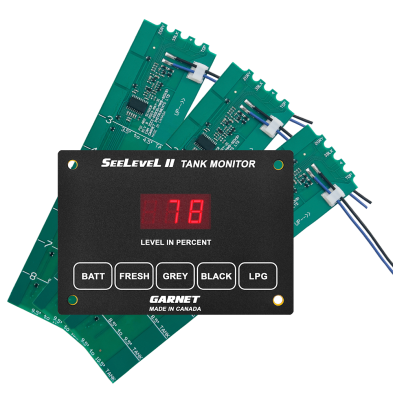When you’re RVing in the cold, a heated water hose isn’t a luxury—it’s your lifeline. This piece of gear is specifically designed with a built-in heating element that keeps the water flowing, no matter how far the temperature drops. Think of it as a smart, self-warming jacket for your RV’s water connection, ensuring you never have to deal with frozen pipes.
What an RV Heated Hose Can Do for You

Waking up to a frozen water line is more than just an inconvenience; it can easily lead to split hoses and expensive, messy damage to your RV’s plumbing. An RV heated water hose is probably the single most important piece of gear for any RVer venturing into cold climates. It doesn’t matter if you’re a full-timer braving a mountain winter or a weekend warrior chasing autumn scenery—you’re going to need one.
This specialized hose guarantees you have fresh water for drinking, showering, and washing dishes, even when the forecast is calling for a deep freeze. It completely eliminates the need for risky DIY solutions, like wrapping a standard hose in heat tape, giving you a safe, purpose-built solution for cold-weather camping.
Shop heated hoses we stock: Camco 12 ft, Camco 25 ft, Camco 50 ft, Valterra 50 ft
With four-season RVing getting more popular, the demand for reliable winter gear has shot up. The global market for related parts, like RV water heaters, was valued at USD 1.2 billion in 2022. That number really shows how the industry is responding to what adventurous RVers need. It also highlights why investing in proper equipment to protect your water supply is so important. You can discover more insights about the growing RV water systems market and see how these trends are shaping the products we use.
Key Benefits of a Heated Water Hose
- Freeze Prevention: Keeps water flowing and protects your plumbing from ice buildup.
- Damage Protection: Avoids burst hoses and downstream repair costs.
- Convenience and Reliability: Set it up once and let the thermostat do the rest.
A common mistake new RVers make is underestimating how quickly an unprotected hose can freeze. It doesn’t take much—even temperatures just below 32°F (0°C) for a few hours can be enough to create a solid block of ice.
An RV heated water hose might seem straightforward, but there’s some clever engineering packed inside that keeps your water flowing when the temperature plummets…
The Brains of the Operation: The Thermostat
When the air temperature drops to near freezing, typically around 38°F (3.3°C), the thermostat automatically clicks on and powers the heat cable. When temps rise, it shuts off to save power.
Comparing Heating Technologies
Thermostat-Controlled (Fixed Output) vs Self-Regulating elements. Self-regulating designs can put more heat where it’s colder and less where it’s warmer—more efficient for extreme swings.
Choosing the Right Heated Hose for Your Setup
Finding the Perfect Length
Use the shortest length that comfortably reaches the pedestal. For most, 25 ft is the sweet spot. If you regularly need more reach, step up to 50 ft.
Quick picks: Camco 25 ft · Camco 50 ft · Valterra 50 ft
Matching Temperature Ratings to Your Travels
- Standard Duty: Often rated ~-20°F — good for most winter trips. See Camco heated hoses.
- Heavy Duty / Arctic: Down to ~-40°F — better for northern winters. Check the product bulletins per listing.
Analyzing Construction and Durability
Prefer machined brass fittings, a tough outer jacket, and potable-water materials. Camco and Valterra listings hit these marks.
RV Heated Water Hose Feature Comparison
| Feature | What to Look For | Why It Matters |
|---|---|---|
| Length | 15/25/50 ft | Shorter = less power, less clutter. |
| Temp Rating | ~-10°F to -40°F | Match rating to expected lows. |
| Fittings | Machined brass | Better cold-weather durability and seal. |
| Wattage | Lower W/ft | Indicates stronger insulation/efficiency. |
Proper Installation and Electrical Safety
- Fully uncoil before use; check rubber washers.
- Hand-tighten first to avoid cross-threading.
- Plug into a GFCI outlet; use a 12/14-gauge outdoor cord if you need an extension.
Step-By-Step Hookup Guide
- Protect the spigot (heat tape + insulated cover).
- Connect hose to spigot (hand-tighten; check for drips).
- Connect to RV inlet.
- Power up safely at a GFCI pedestal.
Maintaining and Storing Your Heated Hose
- Drain completely; sanitize before storage.
- Coil loosely; avoid tight bends to protect the heating cable.
- Store dry, out of sun, rodent-safe (bin in garage/basement/bay).
Troubleshooting Common Heated Hose Issues
Hose Is Not Heating Up
- Check pedestal breaker and outlet.
- Inspect plug/prongs; seat fully.
- Expose the thermostat end to ambient air.
GFCI Keeps Tripping
Moisture is the usual culprit. Dry plug/outlet and use a weatherproof cord cover. If it still trips, element may be failing—replace the hose.
Water Freezes at Spigot or RV Inlet
Insulate the exposed metal ends (spigot, regulator, RV inlet) so your system is protected end-to-end.
Heated Hose FAQs
Can I just use a regular hose with heat tape?
Not recommended. Purpose-built heated hoses are sealed systems with insulation and proper cable routing.
How much electricity does it use?
Typical 25-ft hoses draw roughly 1.5–2.5 A (180–300 W) when heating. Thermostats cycle to limit runtime; self-regulating types are most efficient.
Is the water safe to drink?
Yes—look for potable/lead-free/BPA-free. Camco and Valterra heated hoses are built on drinking-water-safe constructions.
Can I leave it plugged in all season?
Yes. That’s the point—the thermostat handles on/off automatically. Always use GFCI.
Ready to gear up for winter? Grab a heated hose that matches your setup: Camco 12 ft · Camco 25 ft · Camco 50 ft · Valterra 50 ft











